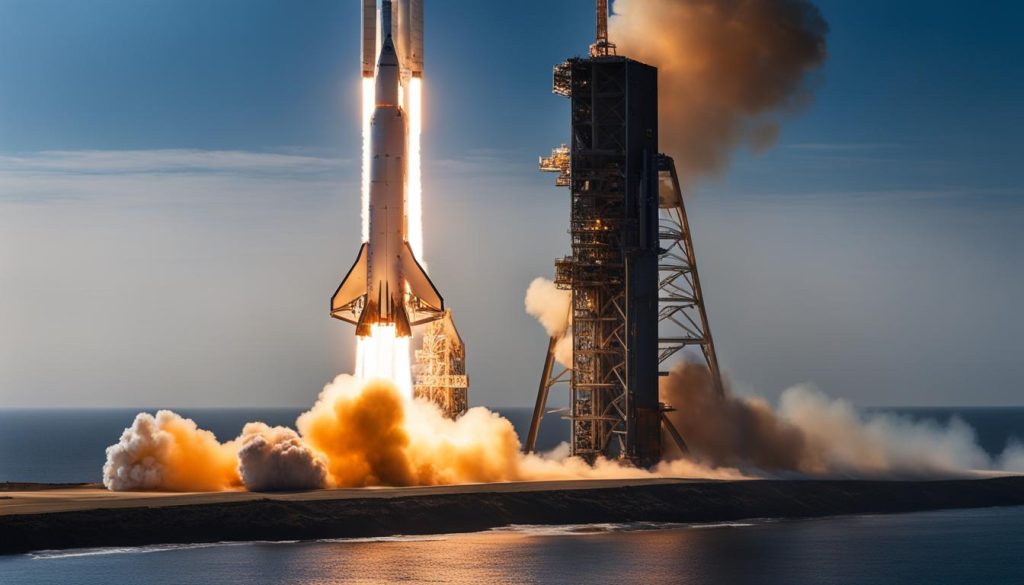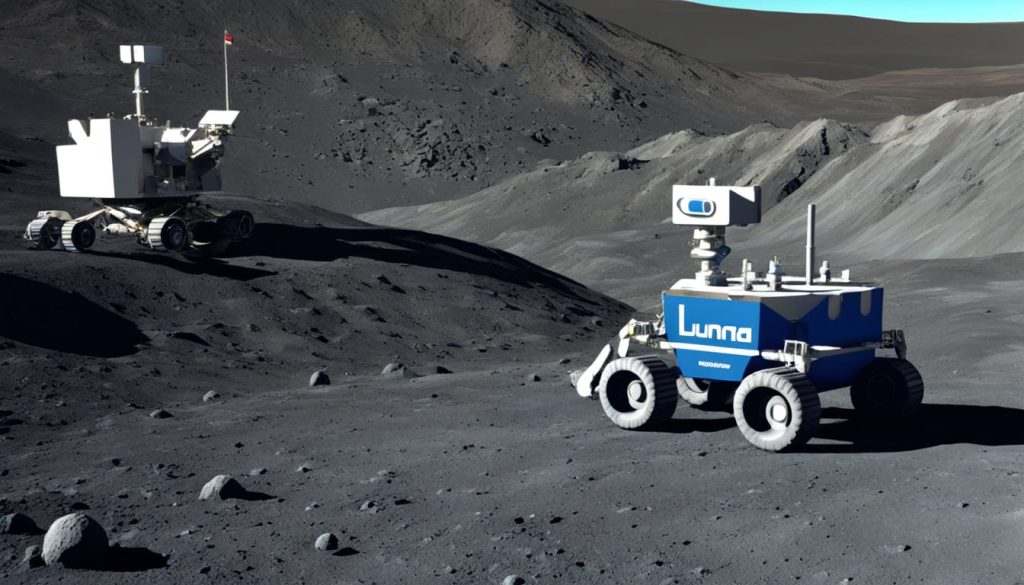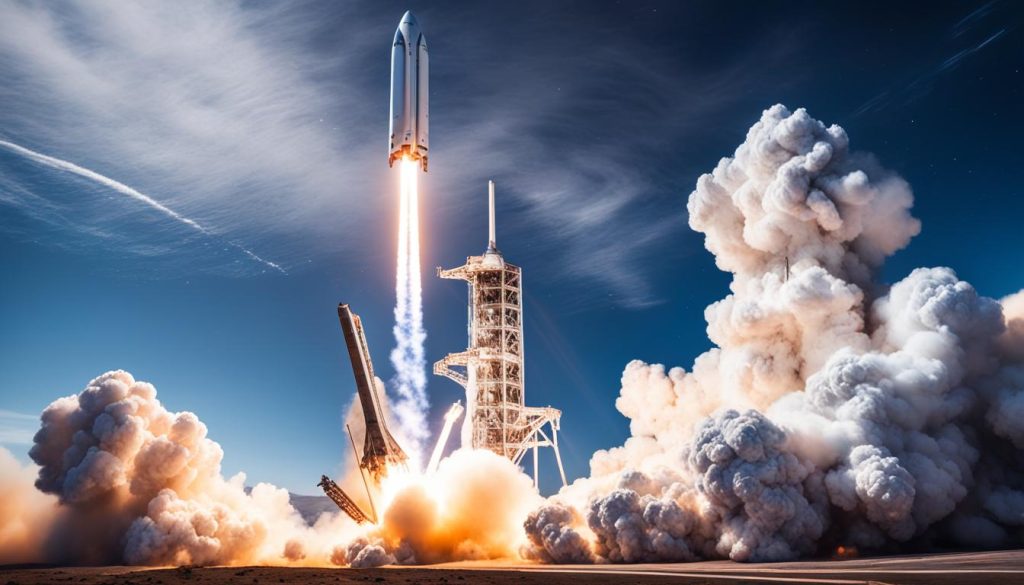SpaceX, founded by Elon Musk, is revolutionizing space travel and making interplanetary exploration a reality. With its advanced technology and successful launches, SpaceX is pushing the boundaries of space exploration. The company’s missions include launching satellites into orbit, resupplying the International Space Station, and even planning to send humans to Mars in the future. The innovative approach of SpaceX has garnered attention and is paving the way for a new era of space exploration.

- SpaceX, founded by Elon Musk, is revolutionizing space travel and exploration.
- The company’s missions include satellite launches, ISS resupply, and future plans for Mars colonization.
- SpaceX’s innovative approach is pushing the boundaries of space exploration.
- The company’s success has attracted attention and is inspiring the next generation of space technology.
- With SpaceX’s advancements, the dream of interplanetary travel is becoming a reality.
Private Companies and Lunar Resource Mining
In recent years, there has been a growing interest in private companies mining lunar resources. A law passed by Congress allows American space companies to claim and utilize resources found on celestial bodies, including the moon. One such venture, Interlune, has raised $18 million and is focused on extracting Helium-3, a valuable isotope abundant on the moon. The company aims to be the first to collect, return, and sell lunar resources, pushing the boundaries of lunar resource utilization and potentially paving the way for future commercial operations on the moon.
The prospect of mining lunar resources opens up new opportunities for space exploration and resource utilization. With private companies like Interlune taking the lead, there is a tangible possibility of establishing sustainable industrial operations on the moon.
As private enterprises delve into space exploration, the potential for commercializing lunar resources becomes a reality. This not only fuels scientific advancement but also encourages collaboration between private entities and government agencies like NASA to drive future missions to the moon and beyond.
Interlune: Extracting Helium-3 from the Moon
Interlune, one of the pioneering private companies in lunar resource mining, has set its sights on extracting Helium-3 from the moon. Helium-3 is a valuable isotope that can serve as fuel for nuclear fusion reactors, offering a clean and abundant energy source for the future. As the first company to collect, return, and sell lunar resources, Interlune is at the forefront of pushing the boundaries of space exploration and resource utilization.
“We believe that lunar resource mining is the key to unlocking the potential of space exploration and advancing our civilization. Our goal is to establish a sustainable presence on the moon and leverage its resources for the betterment of humanity,” said Elon Musk, founder of SpaceX and supporter of Interlune’s mission.
To achieve its ambitious objectives, Interlune plans to conduct an initial prospecting mission to determine the abundance and viability of Helium-3 on the moon. This will be followed by an end-to-end demonstration mission, showcasing the extraction and separation processes required to utilize lunar resources. Ultimately, Interlune envisions full-scale operations on the moon, fueling the growth of space economy and opening up new avenues for scientific, technological, and commercial advancements.
| Benefits of Lunar Resource Mining | Challenges of Lunar Resource Mining |
|---|---|
|
|
Despite the challenges, Interlune’s mission showcases the entrepreneurial spirit and determination to explore and exploit celestial resources. With private companies leading the way, lunar resource mining is becoming a reality, offering exciting prospects for space exploration, technological advancements, and the sustainable development of our civilization.
Challenges and Opportunities of Lunar Resource Mining
While the idea of lunar resource mining holds great potential, there are several challenges to overcome. Setting up a mining operation on the moon and bringing the products back to Earth is complex and expensive. It requires advanced technologies and multiple launches. However, with advancements in space transportation and technology, companies like Interlune see an opportunity to establish a sustainable industrial base on the moon. The growing demand for resources like Helium-3 and the collaboration between private companies and NASA further incentivize lunar resource mining.
Lunar resource mining presents a unique set of challenges due to the inhospitable lunar environment and the need for innovative solutions. One major challenge is the lack of infrastructure on the moon. Companies like Interlune must develop specialized equipment and systems capable of withstanding the harsh lunar conditions. Additionally, transportation logistics pose a significant obstacle, as multiple launches are required to transport equipment, resources, and personnel to and from the moon.
“Mining the moon is an incredibly complex and challenging endeavor,” says Dr. Sarah Johnson, a space exploration expert at NASA. “However, the potential rewards are immense. The moon is rich in resources that can be utilized for future space missions and exploration.”
“The collaboration between private companies like Interlune and NASA brings together the best of both worlds,” highlights Dr. Johnson. “Private industry brings innovation and agility, while NASA offers expertise and support. Together, they can overcome the challenges and create a sustainable lunar resource mining operation.”
Despite the challenges, companies like Interlune are optimistic about the opportunities presented by lunar resource mining. The moon is abundant in resources such as Helium-3, a potential game-changer in clean energy production and nuclear fusion. Furthermore, the exploration and utilization of lunar resources can contribute to scientific advancements and pave the way for future space missions.
The Role of Technology in Overcoming Challenges

Technological advancements play a pivotal role in overcoming the challenges of lunar resource mining. The development of advanced robotics and automated systems can minimize human involvement in dangerous lunar operations. Specialized equipment, such as lunar rovers and drilling mechanisms, are being designed to extract resources efficiently and safely.
Furthermore, advancements in space transportation technology, such as SpaceX’s reusable rockets, have significantly reduced the cost of launching payloads into space. This cost reduction is crucial for making lunar resource mining economically viable. The utilization of reusable rockets enables more frequent launches and provides opportunities for refining techniques and processes on subsequent missions.
Opportunities for Collaboration and Growth
The collaboration between private companies like Interlune and NASA creates a mutually beneficial partnership. Private industry brings the flexibility and innovation required for progress, while NASA’s involvement ensures adherence to scientific standards and offers valuable expertise.
The successful establishment of a sustainable lunar resource mining operation presents a myriad of opportunities. In addition to providing valuable resources for space exploration, the mining industry can stimulate economic growth and create employment opportunities on Earth and potentially on the moon.
“Lunar resource mining has the potential to revolutionize industries back on Earth,” says Dr. Johnson. “From clean energy production to advancements in high-tech sectors like quantum computing, the impact of lunar resources can extend far beyond the realm of space exploration.”
As companies like Interlune push the boundaries of lunar resource mining, leveraging advancements in space technology and harnessing the potential of collaboration, humanity takes another step towards expanding our presence beyond Earth and unlocking the untapped resources of the moon.
Mission Objectives for Lunar Resource Mining
Interlune, a leading company in the field of lunar resource mining, has set ambitious mission objectives to explore the moon for valuable resources. Their primary focus is on Helium-3, a potential fuel source for future energy needs. This section will delve into Interlune’s mission objectives and their timeline for achieving their goals.
In 2026, Interlune plans to embark on a prospecting mission to a specific area on the moon that is believed to harbor significant quantities of Helium-3. The primary objective of this mission is to gather crucial data and measure the abundance of Helium-3 in the lunar surface. By conducting thorough prospecting, Interlune aims to gain insight into the exact composition and distribution of this valuable resource.
If the initial prospecting mission proves successful, Interlune has a comprehensive plan to conduct an end-to-end demonstration of the entire lunar resource mining process. This demonstration, scheduled for 2028, will showcase the extraction and separation of Helium-3 from the lunar regolith, setting the stage for future full-scale operations.
The successful demonstration mission is a crucial step towards making lunar resource mining commercially viable. Interlune envisions achieving full-scale mining operations by 2030, marking a significant milestone in the utilization of lunar resources and opening up new economic opportunities in space exploration.
The mission objectives set by Interlune represent a pivotal step forward in the quest for sustainable resource utilization beyond Earth. By harnessing space technology and exploring the moon’s resources, Interlune aims to contribute to a future where space exploration and resource mining become integral parts of our journey to understand and thrive in the vast cosmic landscape.
Potential Applications of Helium-3
Helium-3, abundant on the moon, has several potential applications. It can be used as fuel in nuclear fusion reactors, a technology believed to provide clean and abundant energy. Helium-3 is also crucial for the quantum computing industry, where systems require extremely cold temperatures to operate effectively. The scarcity of Helium-3 on Earth makes the lunar resource mining endeavors significant and opens up opportunities for industrial and scientific advancements.
“Helium-3, when fused with deuterium, has the potential to release vast amounts of energy. It could revolutionize energy production and reduce our dependence on fossil fuels, paving the way for a sustainable future.”
Potential Use in Nuclear Fusion Reactors
Nuclear fusion, the process that powers the sun, offers a cleaner and virtually limitless source of energy. Helium-3, when fused with deuterium, has the potential to release vast amounts of energy. It could revolutionize energy production and reduce our dependence on fossil fuels, paving the way for a sustainable future.
Critical Role in Quantum Computing
Quantum computers rely on the unique properties of particles at extremely cold temperatures. Helium-3, with its low boiling point, is crucial for creating the required ultra-cold operating environments. Its use in advanced cooling systems allows quantum computers to perform complex calculations with greater efficiency and accuracy.
Opening Doors for Industrial and Scientific Advancements
The scarcity of Helium-3 on Earth makes the extraction and utilization of lunar resources significant. The availability of this isotope on the moon could unlock new possibilities in various fields. Industrial applications, such as energy production and nanotechnology, as well as scientific research and space exploration, stand to benefit from the abundance of Helium-3.
NASA’s Involvement and Plans for Lunar Resource Utilization
NASA, the renowned space agency, is actively exploring the potential of lunar resources for its future missions. The agency recognizes the importance of these resources and has set forth plans to establish a regulatory framework that allows for the extraction and trade of space resources.
In a groundbreaking move, NASA announced in 2020 its intention to purchase rocks and dirt from the lunar surface. This initiative emphasizes the agency’s commitment to creating a sustainable ecosystem for astronauts and fostering the utilization of lunar resources.
By collaborating with private companies and encouraging commercial operations, NASA aims to achieve multiple objectives. Not only does NASA seek to return humans to the moon, but it also aims to stimulate economic growth and drive innovation in space exploration.
Why is NASA interested in lunar resource utilization?
“Utilizing lunar resources is a crucial step for NASA to establish a sustainable presence on the moon and pave the way for future deep space exploration missions.” – Dr. Jack Burns, NASA Chief Scientist
NASA’s interest in lunar resource utilization is driven by several factors, including:
- The potential to establish a long-term habitat on the moon to support human presence and scientific research.
- The opportunity to develop technologies for extracting, processing, and utilizing lunar resources, which could be extrapolated for future missions to Mars and beyond.
- The ability to minimize the reliance on Earth for essential resources by utilizing the vast reserves available on the moon.
Achieving these objectives would enable NASA to expand humanity’s reach in space and open up new possibilities for exploration and scientific discovery.
NASA’s plans for lunar resource utilization
NASA’s plans for lunar resource utilization include:
- Establishing a regulatory framework to govern the extraction and trade of space resources.
- Collaborating with private companies to develop innovative technologies for resource extraction and processing.
- Supporting research and development efforts to explore the potential applications of lunar resources.
- Creating partnerships with international space agencies and organizations to foster global cooperation in lunar resource utilization.
Through these concerted efforts, NASA aims to lay the foundation for sustained exploration of the moon and beyond, spurring economic growth and innovative advancements in space technology.
| Benefits of NASA’s Lunar Resource Utilization | Challenges to Overcome |
|---|---|
|
|
Competition in Lunar Resource Mining
The race to mine lunar resources goes beyond private companies, as China has also expressed a keen interest in extracting resources from the moon. Both NASA and China have set their sights on the lunar south pole, where ice in the form of water is found in shadowed craters. This competition intensifies as companies like Interlune strive to be at the forefront of lunar resource mining, pushing the boundaries of space exploration and commercialization.
| Space Agency | Target Area | Resource Focus |
|---|---|---|
| NASA | Lunar South Pole | Helium-3, Water Ice |
| China | Lunar South Pole | Helium-3, Water Ice |
This competition signifies the growing importance and potential of lunar resource mining. As nations and companies vie for a stake in these valuable resources, it drives innovation and advancements in space technology. The quest for lunar resources continues to fuel excitement and opens up new possibilities for human expansion into the cosmos.
The Importance of Advancements in Space Transportation and Technology
The success of lunar resource mining heavily relies on the continuous advancements in space transportation and technology. Companies like SpaceX have played a pivotal role in demonstrating the immense potential of reusable rockets, which has significantly reduced the cost of launches and made space more accessible.
With ongoing developments, such as SpaceX’s Starship rocket, which NASA plans to utilize for future lunar missions, the capabilities of space exploration continue to expand. These advancements not only make lunar mining operations more feasible but also contribute to the overall growth of the space economy.

Reusable Rockets and Cost-Efficiency
“SpaceX’s innovation in developing reusable rockets has revolutionized the space industry, making it more cost-efficient and enabling frequent launches. The ability to land and reuse rockets significantly reduces the overall expenses, making space exploration more sustainable and economically viable.” – Elon Musk
The development of reusable rockets by SpaceX has significantly disrupted traditional space launch practices. Instead of discarding rockets after a single use, SpaceX’s Falcon 9 rockets are designed to return to Earth and land vertically, ready to be refurbished and flown again. This breakthrough technology has proven highly successful, demonstrating the viability of reusable rockets for space missions.
Enhancements in Space Exploration Capabilities
“SpaceX’s Starship represents a significant leap in space transportation technology, enabling humans to travel to various celestial bodies, including the moon and Mars. It opens up a new era of space exploration and colonization.” – Elon Musk
The ongoing development of SpaceX’s Starship offers enhanced capabilities for space exploration and future lunar missions. With a capacity to carry both crew and cargo, Starship aims to become the most powerful launch vehicle ever built, capable of delivering substantial payloads to destinations within the Earth’s orbit, the moon, and even beyond.
The integration of SpaceX’s technological advancements and NASA’s utilization plans further propels the potential for lunar mining operations. NASA’s Lunar Gateway, a space station planned for lunar orbit, will serve as a critical hub for lunar missions, opening up opportunities for commercial entities to contribute and collaborate in achieving sustainable lunar resource utilization.
| Advancement | Impact |
|---|---|
| Reusable Rockets | Significant cost savings, increased launch frequency, and improved sustainability for space missions. |
| Starship Development | Enhanced capabilities for crewed missions, cargo transportation, and the potential for extended exploration on celestial bodies. |
These advancements in space transportation and technology pave the way for the realization of ambitious lunar mining projects and prolonged human presence beyond Earth. As companies like SpaceX continue to push boundaries and explore new possibilities, the future of space exploration and resource utilization becomes increasingly promising.
Investor Interest in the Space Sector
The success and potential demonstrated by companies like SpaceX have made the space sector increasingly attractive to investors. Venture capital firms, including Seven Seven Six, have recognized the value of ambitious bets on space technology and exploration and have shown a keen interest in investing in space-related ventures.
The advancements in space technology, coupled with the growing demand for resources, have further incentivized investor interest. The potential for significant returns, both in terms of financial gain and the advancement of space exploration, has captivated investors who see the space sector as a promising and lucrative opportunity.
“Investing in the space sector is not just about financial gain; it is about being a part of a groundbreaking journey that will shape the future of humanity. The potential for innovation, scientific discoveries, and the expansion of our presence beyond Earth is remarkable. It’s an exciting time to be involved in the space industry.”
The space sector offers unique investment prospects as it combines cutting-edge technology, exploration of new frontiers, and the potential for resource extraction. As companies continue to push the boundaries of what is possible in space, investors play an integral role in providing the necessary funding to fuel innovation and advancements.
Investment Opportunities in the Space Sector
Investors have a range of opportunities to participate in the space sector, from supporting established companies like SpaceX to investing in startups focused on lunar resource mining and space technology development. The following are some key investment areas in the space sector:
- Launch Services: Companies like SpaceX offer reliable and cost-effective launch services, catering to a growing demand for placing satellites in orbit.
- Lunar Resource Mining: Ventures like Interlune are pioneering the extraction of valuable resources on the moon, such as Helium-3, opening up possibilities for commercialization and future space missions.
- Space Technology Solutions: Startups developing innovative space technologies, such as advanced propulsion systems, satellite communication, and space debris mitigation, present exciting investment opportunities.
- Space Tourism: Companies like Virgin Galactic and Blue Origin are leading the way in the nascent space tourism industry, offering investors the chance to be part of a transformative experience.
Investors in the space sector have the opportunity to be at the forefront of transformative advancements in technology and exploration. As the industry continues to evolve and mature, the potential for substantial returns and societal impact grows.
Investor Confidence in the Space Sector
The success of companies like SpaceX, coupled with NASA’s continued involvement and support for commercial space ventures, has instilled confidence in the space sector among investors. The collaboration between government agencies, private companies, and research institutions further bolsters investor confidence, as it demonstrates a unified commitment to advancing space exploration.
Additionally, the increasing number of successful space missions, such as SpaceX’s resupply missions to the International Space Station, the landing and reusability of rocket boosters, and the successful deployment of satellite constellations, all contribute to a positive investment climate in the space sector.
Overall, investor interest in the space sector is driven by the potential for groundbreaking technological advancements, scientific discoveries, and economic growth. With each successful mission and new milestone achieved, the space sector solidifies its position as a compelling investment opportunity with the potential to shape the future of humanity’s presence beyond Earth.
Conclusion
SpaceX’s groundbreaking innovations and the ambitious endeavors of companies like Interlune in lunar resource mining have opened up new frontiers and sparked immense excitement in the realm of space exploration. Through collaborative efforts between the private sector and NASA, and propelled by advancements in space transportation and technology, we are edging closer to the realization of interplanetary travel. The future of space is brimming with endless possibilities.
As the space economy continues to flourish, we can anticipate a multitude of remarkable discoveries and scientific breakthroughs that will not only reshape our understanding of the universe but also transform our everyday lives on Earth. The commercialization of space and the expansion of human presence beyond our planet hold vast potential for technological advancements that will benefit humanity as a whole.
The dream of space travel is gradually becoming a reality, thanks to the persistent efforts of pioneers like SpaceX and the growing ecosystem of space technology. The possibility of interplanetary settlements and the gradual exploration of celestial bodies ignite our collective imagination and inspire generations to push the boundaries of what we thought was possible. The journey to the stars has just begun, and the future holds uncharted territories waiting to be explored.

